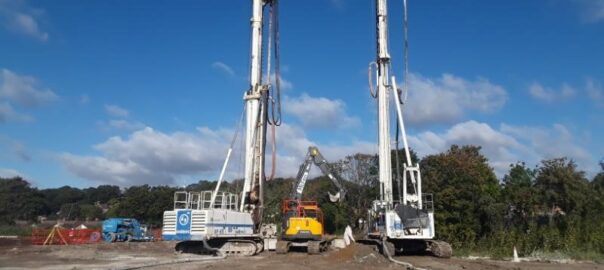01/07/2022
Central Piling is using two continuous-flight auger (CFA) piling rigs to install deep foundations on a former quarry site in Kent.
The project is the latest phase of a major residential development on behalf of the Erith Hills LLP, made up of Anderson and L&Q, comprising 849 new homes, a new primary school and a 12-acre ecology park.
Called, appropriately enough, The Quarry, the scheme occupies a disused 50-acre quarry in Erith that had lain untouched for more than 30 years.
Central Piling has been working on-site since 2021, installing piles to support the new development. Due to the nature of the site, the ground conditions are highly variable, with large areas of mixed fill reaching depths of up to 30m in some places.
The challenge here is to install piles that are deep enough to reach firm ground – and that means piles up to 40m deep.
“Rotary piling wasn’t feasible due to the depth of casing required and driven piling might not have penetrated harder elements within the fill,” says Central Piling managing director Steve Hadley.
Instead, Central Piling chose to use CFA piling techniques. But that gave rise to another challenge: few CFA piling rigs can drill down beyond 30m. “There are rigs that can drill to about 36m but they are huge, 120-tonne machines,” explains Steve.
Central Piling has overcome this problem by deploying two piling rigs, working in tandem. Both are Italian-made Soilmec machines: an SF50 CFA rig and its larger stablemate, the SF65 rig.
The larger of the two rigs is used to install the first stage of the pile. “This is the main machine,” says Steve. “It can drill down to 29.5m”.
Once the SF65 has drilled to about 24m, it decouples and backs away to allow the smaller SF50 to position itself over the first auger, to which it couples its own auger. This machine then continues the boring process to reach the required depth.
“This presented a safer and higher-production solution than adding single 6m sections of auger to a single rig,” explains Steve.
Nevertheless, to make this system work, Central Piling had to develop a special tool for supporting the drilling tools as the rigs were swapped during the concreting stage of the operation. The team also configured the drum and pump set-up with a valve that allowed concrete to be shared between the two machines.
Even if a 120-tonne rig had been available, Steve doubts it would have proved suitable for this site. “It’s quite tight in some places but having two machines that can move independently means we can get into those spaces,” he says.
“I’ve never heard of anybody using two rigs in tandem like this – as far as I know, it’s a first,” Steve adds.
Piling in such ground inevitably means encountering unforeseen conditions. “We did encounter some locations of deeper fill as well as some voids,” says Steve. “This necessitated close inspection of the arisings and a suitable adjustment to the design length [of the pile].”
When such conditions arose, Central Piling had to adapt its procedure – for example, by altering extraction rates to maintain concrete pressure, and pumping additional concrete to fill voids, to ensure successful results. “In some places we had to re-drill in order to install viable piles,” says Steve. “Of course, our client understood the variability inherent on this site and were accommodating to these changes”.
ENDs

